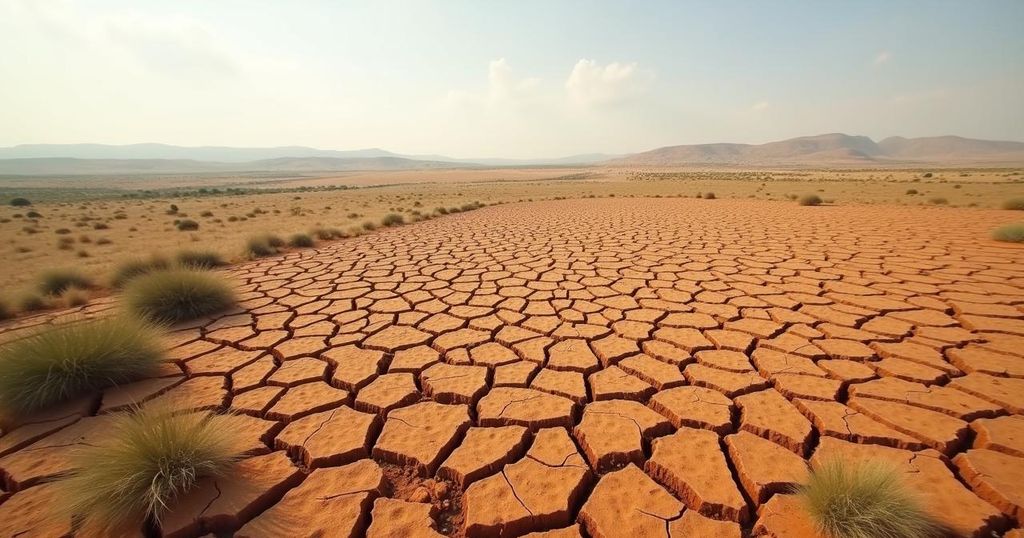Crisis Analysis: Drought Impacts in Southern Africa during 2023/2024 El Niño

The 2023/2024 El Niño has caused severe drought across Southern Africa, impacting food security, health, and sanitation. Approximately 23 million people face food insecurity, with urgent humanitarian assistance needed, particularly in Malawi, Zambia, Zimbabwe, and Mozambique. The crisis includes significant malnutrition cases among children and ongoing disease outbreaks in an already vulnerable region.
The 2023/2024 El Niño phenomenon has precipitated an unprecedented drought across southern Africa, resulting in severe humanitarian crises in Angola, Botswana, Lesotho, Malawi, Mozambique, Namibia, Zambia, and Zimbabwe. Characterized by delayed rainfall, extended dry periods, and soaring temperatures, this El Niño is considered the most severe in four decades. Communities that were already struggling with failed crops and adverse economic circumstances are now facing dire food shortages, compromised access to clean water, livestock losses, and widespread disease outbreaks. According to national government reports and estimates from the Famine Early Warning Systems Network (FEWS NET), the drought has led to significantly reduced maize harvests, with figures falling well below the average for the preceding five years. A staggering 23 million individuals across the region are presently experiencing acute food insecurity, with the greatest impact felt in Malawi, Zambia, Zimbabwe, and Mozambique. Projections indicate that between 14.0 and 14.9 million people will require immediate humanitarian assistance during the lean season from October to December 2024. Six nations, namely Botswana, Lesotho, Malawi, Namibia, Zambia, and Zimbabwe, have formally declared national drought disasters, while millions in Angola and Mozambique are also grappling with food insecurity, estimated at 1.8 million and 3.3 million respectively. The 2024 crisis also forecasts that over two million children will experience acute malnutrition, including more than 500,000 suffering from severe wasting. The intensifying drought conditions have displaced thousands, contributing to outbreaks of disease, exacerbating food shortages, and limiting water availability. These challenges compound existing vulnerabilities to various epidemics, notably cholera and measles, while the emerging risk of mpox threatens to draw resources away from drought response efforts in some countries. As the region battles one of its most severe cholera outbreaks in decades, ongoing water shortages hinder effective hygiene and sanitation practices, perpetuating a cycle of vulnerability, particularly in Malawi and Mozambique. Additionally, the drought may exacerbate the transmission of HIV and AIDS, contribute to mental health crises, and elevate incidents of gender-based violence. Collectively, these factors illuminate the urgent necessity for improved preparedness and responsive measures. The compounded crises stemming from El Niño, infectious disease outbreaks, and climate change have profoundly disrupted health systems within Southern Africa, severely limiting access to vital reproductive health services. Furthermore, an estimated one million individuals have been internally displaced due to disasters associated with climate change, primarily from Malawi, Mozambique, and Zimbabwe.
The article discusses the severe drought conditions in Southern Africa resulting from the 2023/2024 El Niño event, which has created significant humanitarian challenges across multiple countries. This includes dramatic drops in crop yields, rising food insecurity, and public health concerns exacerbated by existing vulnerabilities in health systems. The information reflects the current state of emergency in the region, highlighting the interlinked crises of climate change, health, nutrition, and sanitation.
In conclusion, the 2023/2024 El Niño event has resulted in a catastrophic drought across Southern Africa, profoundly affecting food security, public health, and overall community resilience. The situation calls for immediate humanitarian assistance to millions facing food insecurity and heightened health risks, alongside a comprehensive approach to strengthen health systems and preparedness against future emergencies. Collaborative efforts must be prioritized to address these intertwined challenges effectively.
Original Source: reliefweb.int






